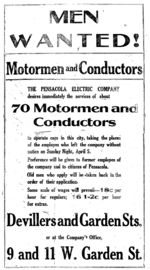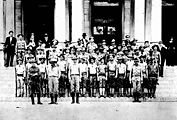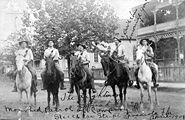Difference between revisions of "Streetcar operators' strike"
(new image.) |
m (cat) |
||
| Line 19: | Line 19: | ||
*"Pensacola Riots Renewed.; Strikers' Mob Attacks Street Car and Fatally Wounds Conductor." ''New York Times'', April 22, 1908. | *"Pensacola Riots Renewed.; Strikers' Mob Attacks Street Car and Fatally Wounds Conductor." ''New York Times'', April 22, 1908. | ||
{{refend}} | {{refend}} | ||
| + | |||
| + | [[Category:Demonstrations & unrest]] | ||
Revision as of 14:55, 7 March 2008
A violent labor strike was staged in Pensacola from April 7–May 13, 1908 by streetcar operators employed by the Pensacola Electric Company. The striking workers attempted to organise a local chapter of the Amalgamated Association of Street Electric Railway Employees of America (now the Amalgamated Transit Union). The strike resulted in several deaths and caused the Governor of Florida to order the State militia into Pensacola.
On April 7, streetcar operators working for the Pensacola Electric Company, the operator of Pensacola's electric streetcar transit system, went on strike. On April 12, Florida Governor Napoleon B. Broward ordered the State militia into Pensacola to protect strikebreakers and restore order. On April 14, under protection of the militia, the city's streetcars were run for the first time in nine days. The city remained calm for about one week until April 21, when a mob attacked a streetcar and fatally wounded the conductor, a G. Hoffman. Stenographer W. L. Wittich, Jr. was also fired upon while boarding a streetcar.
Images
State militia camping in the median of Palafox Street
State militia outside the Old Escambia County Courthouse
State militia posing on the steps of the Federal Customs House & Post Office
References
- "Troops Sent to Pensacola.; Electric Cars Will Be Started To-day Despite the Strike." New York Times, April 13, 1908.
- "Run Cars with Troops.; Pensacola Line Is Operated for the First Time in Nine Days." New York Times, April 15, 1908.
- "Pensacola Riots Renewed.; Strikers' Mob Attacks Street Car and Fatally Wounds Conductor." New York Times, April 22, 1908.






